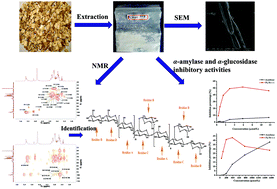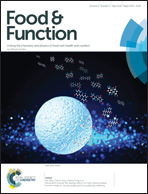Isolation, purification, characterization and bioactivities of a glucan from the root of Pueraria lobata
Abstract
The root of Pueraria lobata is considered to be a medicinal and edible herb for the treatment of diabetes, and it has a long history of application in China. To explore the constituents responsible for the anti-hyperglycemic activities of P. lobata, a water-soluble polysaccharide (PL70-1-1) was isolated and purified by using a DEAE-Cellulose 52 anion exchange column and a Sephacryl S-100 gel filtration column. Its molecular weight (2584 Da) was determined by high performance gel permeation chromatography (HPGPC). Its structure was deduced by Fourier transform-infrared spectroscopy (FT-IR), monosaccharide composition analysis, gas chromatography coupled with mass spectrometry (GC-MS) and nuclear magnetic resonance spectroscopy (NMR). It was deduced that PL70-1-1 was a glucan, and its main chain consisted of (1→)-linked β-D-glucose, (1→4)-linked α-D-glucose, (1→4, 6)-linked β-D-glucose, and (1→3)-linked α-D-glucose, and the branch chain consisted of (1→)-linked β-D-glucose. The results of scanning electron microscopy showed that PL70-1-1 had a needle-like shape, and the surface had a scaly texture. The Congo red experiment showed that PL70-1-1 did not have a triple-helix structure. In addition, PL70 and PL70-1 displayed selective inhibitory effects on α-amylase and α-glucosidase in vitro. PL70 had remarkable α-glucosidase inhibitory activity. However, PL70-1-1 exhibited outstanding α-amylase inhibitory activity, with an IC50 of 3.945 μM in vitro. This indicated that its activity was 417 times higher than the positive control acarbose. PL70-1-1 may be beneficial as an α-amylase inhibitor, reducing the postprandial blood glucose level and treating type 2 diabetes.



 Please wait while we load your content...
Please wait while we load your content...